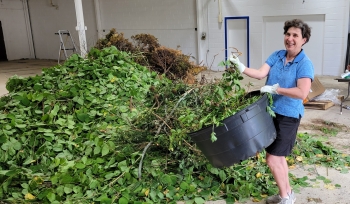
We cut and pull plants and branches to neaten and manage outdoor spaces. It arrives at brush dumps and town transfer stations. What happens next?
“There’s been more and more plant debris every year,” says Larry Bonin, director of the Department of Public Works for Old Saybrook. “We’re running out of space and ways to manage it.” Bonin says the Old Saybrook Transfer Station processes general yard waste in a tumble grinder and turns it a few times to make compost. This step helps to reduce mass, “but it’s not managed in a way that creates a clean, seed-free compost product,” he says.
Clean, finished compost results from a science-based process. The process is beyond the scope of most waste management operations, though municipal experiments are springing up around the state. Bonin says his department gives some of the material to commercial compost makers and farmers. Some of it, however, also winds up in landfills.
Furthermore, seeds often escape this simple composting process. Temperatures are not high enough to ruin the seed. Some seeds are viable for years.
Bonin says, “Wherever that material goes, we may be spreading invasive plants back into the landscape.”
What are the alternatives?
In Old Lyme, CT, an all-volunteer group called Nix the Knotweed was plastic-bagging stalks and sending them to the landfill. That means they will either take a long drive to an Ohio landfill or end in a trash incinerator around the state. Nix the Knotweed's search for an alternative luckily coincided with the launching of a new biochar facility in Old Saybrook.
There, William Hessert and his business partner, Javaughn Henry, have plunged into the commercialization of a technology that has the potential to shrink unwanted “green” mountains at brush dumps. Their venture is called BluSky.io.
“We take different organic wastes like brush and food and convert them into useful products," says Hessert.
Now, knotweed from Nix the Knotweed's cuttings are among the materials fueling test runs of BluSky’s newly installed equipment.
Learn more about current brush disposal methods and alternatives at Zip06/TheDay.
This is Part 2 of the article, "After the Flowers Are Planted."
